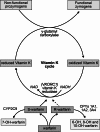Pharmacology of anticoagulants used in the treatment of venous thromboembolism
- PMID: 26780737
- PMCID: PMC4715843
- DOI: 10.1007/s11239-015-1314-3
Pharmacology of anticoagulants used in the treatment of venous thromboembolism
Erratum in
-
Erratum to: Pharmacology of anticoagulants used in the treatment of venous thromboembolism.J Thromb Thrombolysis. 2016 Aug;42(2):296-311. doi: 10.1007/s11239-016-1363-2. J Thromb Thrombolysis. 2016. PMID: 27145758 Free PMC article.
Abstract
Anticoagulant drugs are the foundation of therapy for patients with VTE. While effective therapeutic agents, anticoagulants can also result in hemorrhage and other side effects. Thus, anticoagulant therapy selection should be guided by the risks, benefits and pharmacologic characteristics of each agent for each patient. Safe use of anticoagulants requires not only an in-depth knowledge of their pharmacologic properties but also a comprehensive approach to patient management and education. This paper will summarize the key pharmacologic properties of the anticoagulant agents used in the treatment of patients with VTE.
Keywords: Anticoagulants; Direct oral anticoagulants (DOAC); Heparins; Mechanism of action; Pharmacology; Warfarin.
Figures




References
-
- Kearon C, Akl EA, Comerota AJ, et al. Antithrombotic therapy for VTE disease: antithrombotic therapy and prevention of thrombosis, 9th ed: American College of Chest Physicians evidence-based clinical practice guidelines. Chest. 2012;141(2 Suppl):e419S–e494S. doi: 10.1378/chest.11-2301. - DOI - PMC - PubMed
Publication types
MeSH terms
Substances
LinkOut - more resources
Full Text Sources
Other Literature Sources
Medical

